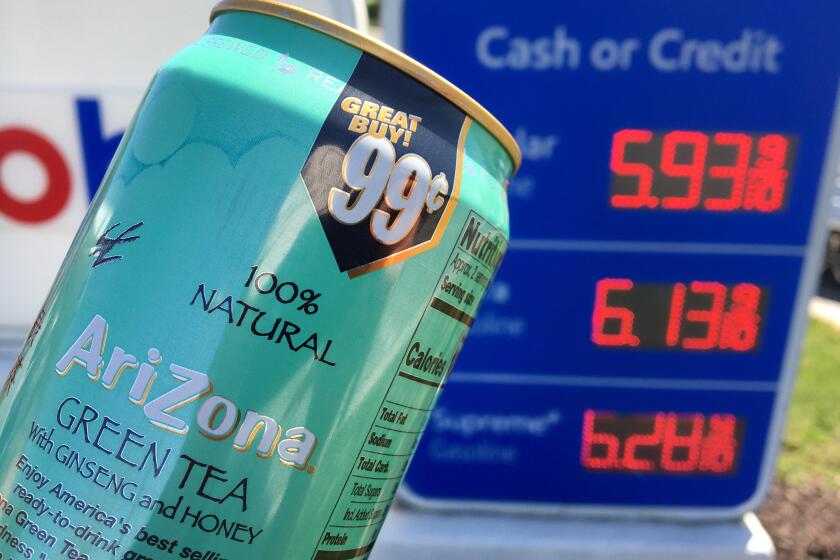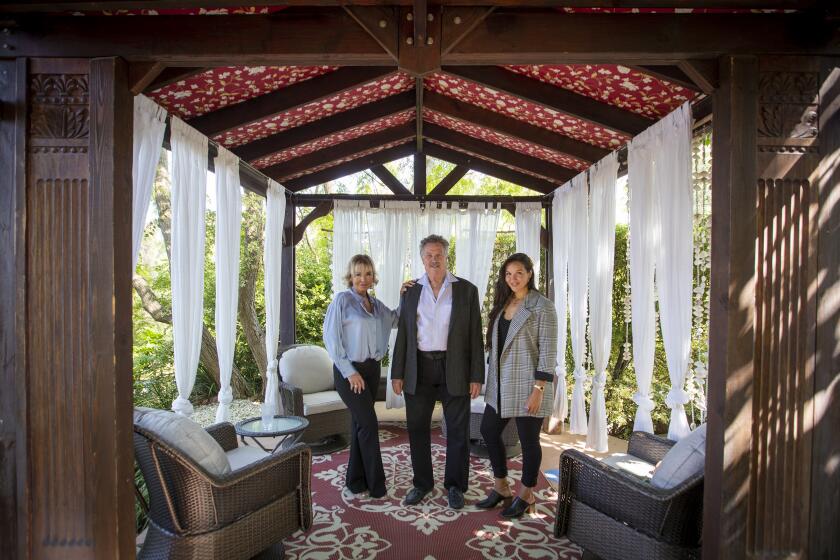Jess Hutchison/Los Angeles Times
- Share via
During a bike tour through Venice over spring break, Meeka Smith and her teenage son stopped for a quick snack at Gjelina Take Away.
She placed her order at the counter-service spot, which automatically adds a 15% service charge to all purchases, and peered down at a glowing screen prompting her for an additional tip. She tacked on 10%.
“I tend to just see it, and I give it,” said Smith, who was visiting Southern California from Baltimore.
A month earlier, Edward Aguilar, a college freshman in the Chicago suburb of Lake Forest, picked out a jersey for his girlfriend from the gift shop at a hockey game and bristled when he noticed the high default tip amounts on the screen, including one for $20. A bit ridiculous, he thought, but the shop employee was staring back at him earnestly and a row of drunk fans in line behind him could clearly see the screen.
“And, of course, I tipped ‘cause of social pressure,” he said, with a laugh. “It’s a social tax.”
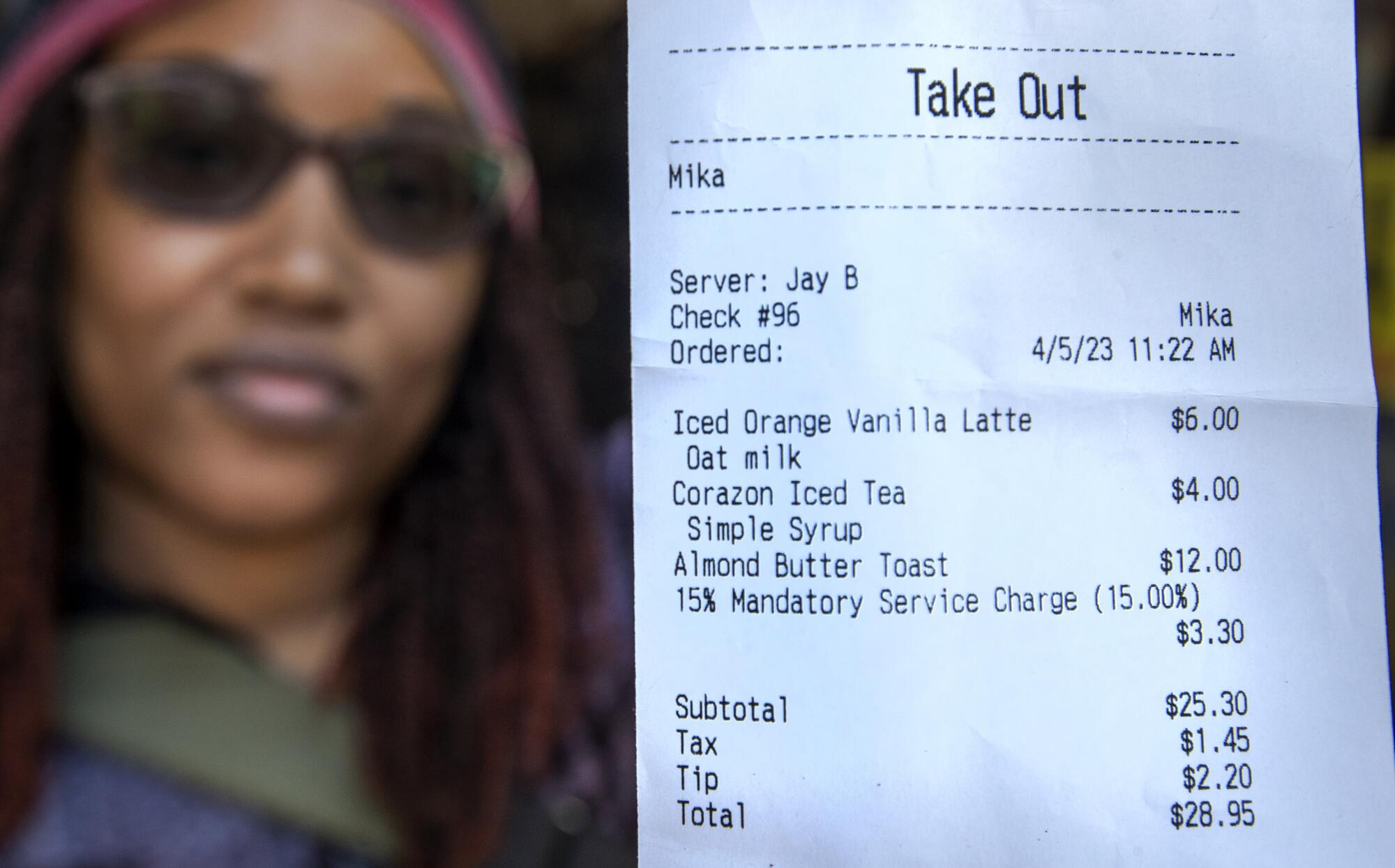
A few days earlier, Rachel Mason, who had noticed a certain frostiness from some baristas in Denver on the rare times she didn’t tip, posted a poll question for her followers on Twitter: “Do y’all think tipping culture has gotten out of control?”
Nearly 86% of the people who voted responded, “Absolutely.”
The norms around who, and how much, Americans tip have shifted in recent years — an evolution experts tie to the advent of tablets with quick-tap default tip options from companies such as Square and the rewiring of consumer tipping habits, at least temporarily, during the pandemic.
For decades, etiquette around gratuity was more or less agreed upon: A 15% to 20% tip, depending on the level of service, for the people who cut your hair, made your drinks and drove your taxi, as well as anyone earning the sub-minimum wage for tipped-rate jobs, such as restaurant servers. Maybe a buck in the tip jar at coffee shops, or maybe not.
But today, consumers sometimes get prompted to tip the workers who package their online orders or when snagging a $6 bottle of water at the airport. And as tip jars have been replaced by the swivel of sleek tablets with default percentages followed by a seemingly ubiquitous refrain — “Just a couple quick questions for ya!” — many consumers feel increasingly exasperated.
They say they want workers to earn a livable wage but believe that employers, and especially big corporations, should pay their workers higher wages, instead of offloading the burden onto consumers who are already stressed about inflation and the looming fear of a recession.
Tall cans of AriZona iced tea have cost 99 cents since 1992. The family behind the company says it’s committed to that price even as the prices of aluminum and corn syrup climb higher.
The phenomenon has several nicknames, including “guilt tipping” and “tipflation,” and has spawned a subgenre of online satire, including a TikToker impersonating an eye surgeon soliciting tips before deciding how carefully to conduct your procedure and a tweet joking that the default options at a local coffee shop might as well be 25%, a kidney or a first-born child.
“It’s everywhere now,” said Kwabena Donkor, an assistant professor of marketing at the Stanford Graduate School of Business, who has studied tipping habits. “People are reacting to that, saying it seems a bit ridiculous.”
Several years ago, while working as a cab driver in New York City to pay his way through college, Donkor, who had recently emigrated from Ghana, found himself increasingly perplexed by tipping customs in the U.S. Even when he had a somewhat unpleasant interaction with a rider, he said, they still left him a tip.
“Why?” he wondered.
Donkor went on to study data from a billion cab rides paid for with credit cards and found that almost everybody — 97% of riders — left a tip, suggesting a strong social norm.
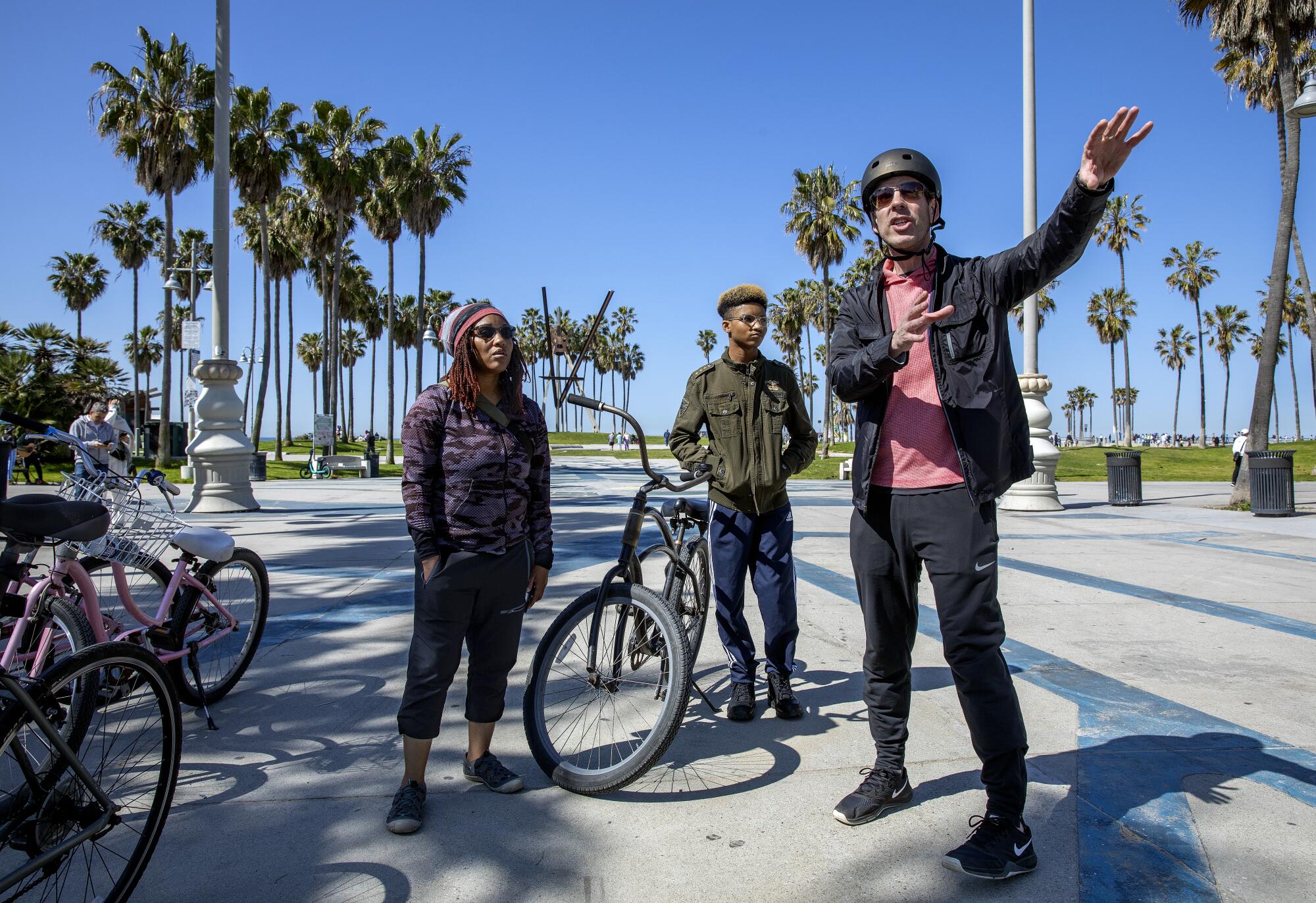
“You don’t want to be seen as a cheapskate,” Donkor said. But also not as a sucker.
Consumers have an “ethical-ideal tip” in their mind — say 17% — and if presented with a slightly-higher default option — maybe 20% — they’re likely to pay it, Donkor said. But his research found that when riders were shown a default percentage much higher than their mental ideal — say 30% — they were more prone to skip the default choices altogether.
“Now I feel like you’re trying to screw me,” Donkor said.

The exact history and timeline of tipping in the U.S. remains somewhat murky, but like many American traditions it has roots in racism and classism.
Many historians and scholars have tied the advent of tipping in the U.S. to well-off Americans visiting Europe in the 1800s, picking up on the trend of tipping servants and instituting the habit back home in an attempt to establish their aristocratic bona fides.
But it grew to greater prominence in the years after the Civil War, as white business owners in the restaurant and rail industries — two of the main jobs available to formerly enslaved Black people at the time — refused to pay wages to Black workers, who were forced to rely only on tips, according to Saru Jayaraman, director of the Food Labor Research Center at UC Berkeley and author of “Forked: A New Standard for American Dining.” To this day, the federal minimum wage for tipped workers in service industry jobs disproportionately held by people of color, immigrants and women is $2.13, far below the minimum wage.
As more Americans benefit from federal aid during the pandemic, some believe the discourse about the role of government in U.S. life could shift.
In recent months, Aguilar, the college student who was prompted to tip at a hockey game, began collecting examples of shops and companies that refuse tips on principle as part of a research project for his macroeconomic theory class.
Tipping is “pretty problematic,” reads the website of Seattle-based ice cream chain Molly Moon’s, which adds “it’s our responsibility — not yours — to pay a full and fair wage to our employees.”
“Tipping can feel awkward and obligatory for the customer, this is not our style,” reads a sign at Top Out Cafe in Indianapolis, which listed wages among a host of no-tip reasons.
That point really resonated, Aguilar said, noting that when he makes purchases he sometimes notices the worker watching what direction his hand is swiping. If it seems to be moving toward the “no tip” or “custom tip” button, he said, he’ll sometimes spot the worker flinch a bit.
“There is so much peer pressure,” he said. “It’s like middle school every time you want to go get a coffee.”
He almost always tips, because he knows workers deserve to earn a livable wage, but he said he’s frustrated that corporations get away with paying lower wages, because they know workers can supplement their income with tips from generous consumers.
“They are exploiting our kindness,” he said.
Mason, the Denver resident who recently posted the Twitter poll, said she, too, would like to see a move away from tipping, a practice she knows as both a consumer and a worker.
Now an airport ramp controller, Mason used to work as a hairstylist in Illinois, making $8.25 an hour, then the state’s minimum wage. The salon was in a dying mall, she said, but on good days she sometimes made $50 to $100 in tips — a bonus that really helped, but one she forced herself not to expect.
She made a point not to judge customers who didn’t tip, she said, because she knew they might be barely scraping by. So it bothers her now, she said, on the rare times she doesn’t tip at a coffee shop and notices a slight shift in the barista’s demeanor.
“Where do you draw the line,” she said, “of guilt tripping people into tipping?”

On a brisk Wednesday recently, Smith and her son arrived at a shop in Santa Monica to pick up their bike rentals for the morning.
They were greeted by Damien Blackshaw, founder of the Real Los Angeles Tours, who, after getting several questions from foreigners through the years, wrote a history and how-to guide for tipping in L.A.
The webpage, which he said gets thousands of views a month, lists a rubric he created with input from other Angelenos: 15% to 20% at restaurants; $2 per drink at bars; 10% for taxis; and $5 to $10 for housekeeping every time they change the sheets. And for tour guides?
The webpage advises: “15-20% of the per person ticket price. What did you think we’d say?! Tour guides work hard.”
Even though the tour guides at his company get paid well above the minimum wage — $25 to $50 an hour, he said, depending on the size and duration of the tour — there’s no amount they could earn, he said, that would make them not also want a gratuity.
“A tip is a sign of respect for a job well done,” he said.
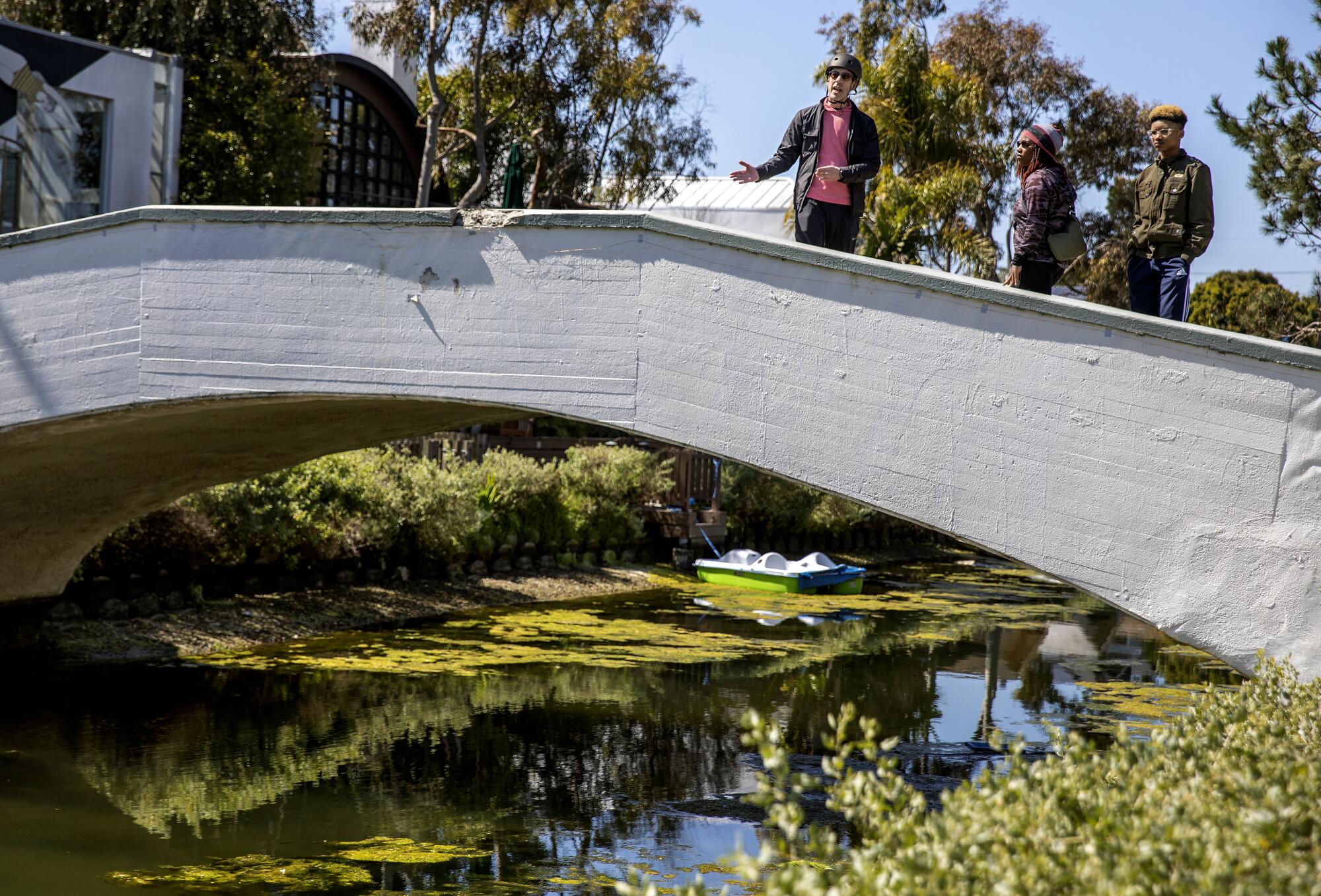
At the start of their bike tour, after Blackshaw introduced himself and explained the tour route, he said that, if at the end of their excursion, Smith and her son had enjoyed themselves, he could give them a QR code to scan and leave a review and, if they wanted to, a cashless tip.
Then, after waiting for a delivery robot to mosey past them on the sidewalk, the trio zipped off, heading first to the Santa Monica Pier and then to the skatepark on Venice Beach. A man sitting on a bench nearby held a sign offering hugs for $2 and a woman performing on roller blades in a tutu had fashioned a tip jar out of a gallon water jug.
Next up was Muscle Beach and the Venice Canals and then their quick stop at Gjelina Take Away, where Smith ordered an iced vanilla orange latte, almond butter toast and an iced tea. Before hopping back on her bike, she peeked down at her receipt, which had a line explaining the automatically added 15% service charge.
“This helps to ensure the wellbeing of our staff,” the note read.
The total price tag? $28.95.
“That’s L.A. for you,” Blackshaw said.
Smith, who works as a project manager, said her default tip amount is 20% and sometimes more for great service. She knows a lot of service jobs pay low wages, so she tries to do her part to supplement what workers bring in — a generosity she feels better about while purchasing from small businesses, she said, than from big chains.
A few minutes later, after the group returned to the Santa Monica bike shop, Smith told Blackshaw how much she’d enjoyed the experience.
“Thanks for the awesome tour,” she said, asking him the best way to tip.
“Is Venmo good?” he said.
Smith nodded, pulling the app up on her phone. The ticket price for two people was $130 and 20% of that was $26.
She rounded it up to $30.
- Share via
Watch L.A. Times Today at 7 p.m. on Spectrum News 1 on Channel 1 or live stream on the Spectrum News App. Palos Verdes Peninsula and Orange County viewers can watch on Cox Systems on channel 99.
More to Read
Inside the business of entertainment
The Wide Shot brings you news, analysis and insights on everything from streaming wars to production — and what it all means for the future.
You may occasionally receive promotional content from the Los Angeles Times.
